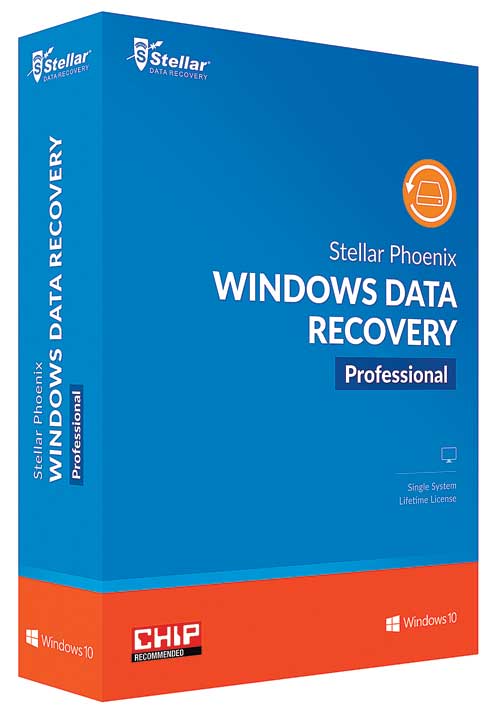
STELLAR PHOENIX
Windows Data Recovery
Price: Rs 3,999; Rating: 8/10
What it is: Ever deleted a file or formatted a drive or an SD card, only to realise you had some invaluable documents and photos stored on it? Stellar Phoenix Windows Data Recovery, available for Windows 10, 8, 7, Vista and XP, may just be the tool you need. The software scans inaccessible data storage for all types of data and displays all the recoverable files and folders in a Windows Explorer-style tree structure for you to restore.
Pros: The whole process of file recovery is intuitive, and the software is clearly targeted at first-time users. There’s even a free trial which allows you to recover up to 1GB of data at no cost. A quick scan is usually sufficient for deleted files, but if you’ve formatted a partition, there’s even an advanced Deep Scan which searches the required location comprehensively and reports the raw recovery results. Advanced users will appreciate the ability to recover even from scratched or damaged optical media like CDs and DVDs, and the option to create an exact replica of your entire hard drive (useful if you suspect data corruption).
Cons: Works as advertised, and the few formatted drives and SD cards I crunched through the software were restored completely. Keep in mind that the Deep Scan can take a fair bit of time if there’s a large volume of data you’re looking to restore.

BOSE SOUNDLINK REVOLVE+
Price: Rs 24,500; Rating: 8/10
What it is: Cylindrical 360-degree Bluetooth speakers which promise full-range sound without having to worry about placement are gaining popularity these days, and the SoundLink Revolve+ is Bose’s fashionably late but considered entry into the space.
Pros: With its integrated handle, the Revolve+ has a strong lantern vibe about it and makes for easy portability in the house. The unibody aluminium enclosure is sturdy and well-made and the water- and shock-resistant design should put up with less-than-gentle treatment. The buttons on top control music playback and activating voice assistants like Siri and Google Assistant, and the USB cable can be used to play music from a PC, a neat and rather uncommon addition. Where it shines is the sound quality — sounding as good or even better than anything its size. Volume levels go pleasantly high without distortion, much bigger than its size would indicate, and enough to fill a mid-sized to large room. It delivers good detail and powerful lows, though I did notice bass response is far better when you place the speaker near the walls rather than at the centre of the room.You can pair two Revolve+ speakers for stereo effect or amplification, and the battery lasts a decent 16-18 hours.
Cons: While charging is via the included USB cable, I wish Bose included the optional charging cradle in the box.
.jpg)
PORTRONICS SEESAW
Price: Rs 3,999; Rating: 9/10
What it is: If you’re in the market for a wireless home security camera without breaking the bank, you should take a serious look at the Portronics SeeSaw. It offers HD 720p resolution, day/night viewing, two-way audio, motion detection and microSD support for local storage.
Pros: The SeeSaw is WiFi-enabled, so the only wire you need to run is a microUSB cable to a power source, and the strong magnetic base is handy to attach it to almirahs or the fridge. Installation is a snappy process with the U-Cam app, and you can use the app to set up motion detection or remotely monitor the view. Video streamed at 30fps is clear and smooth, and the camera automatically shifts to monochrome mode when light levels drop.
Cons: It lacks any motorised pan or tilt capability, but the lens is wide enough to cover most of your room if it’s placed in a corner. The speaker could have been a tad louder.

NOKIA 3310
Price: Rs 3,310;
Rating: 7/10
What it is: The Nokia 3310 is a 2017 refresh of the iconic original, and you now get a feature phone which can take 2MP images, play music and a few games (including an all-new Snake!), apart from making calls and sending SMSes.
Pros: It isn’t an exact replica of the original, but it has similar rounded corners, a chunky design and keys, and it’s still small enough to disappear into any pocket. Lovely range of colours too. The 2.4-inch, 240x320 resolution colour display is as pixelated as any other phone at the turn of the century, but it does the job — it’s bright and easy to read. The battery life is its true strength — standby time is a full month, and with little to do on this phone, the charge lasts several days of use.
Cons: The Series 30+ OS feels almost childish today, and with only 2G support, it’s just as well you don’t have access to a lot of apps. Internal space is limited (1.5MB) though there is support for 32GB microSD cards. The camera is there only in name. And it doesn’t have call recording, only voice recording for voice memos. Consider it only for the nostalgia — even as feature phones go, there are better options.

XIAOMI MI ROUTER 3C
Price: Rs 1,199; Rating: 8/10
What it is: The Mi Router 3C is Xiaomi’s first router in India and, for an entry-level router, the Mi Router 3C comes packed with features that are rare at this price point.
Pros: The clean all-white design and sleek looks are a departure from the drab looking, LED-packed routers at this price point. Setup is easy if you use the Mi WiFi app and once you’re done, the browser administration pages have a clean and easy-to-use interface. You can easily see the connected devices, their bandwidth consumption, and so on, and change a number of settings like device quotas, quality of service (QoS) parameters, or set-up, and control a guest network. Use the app and you gain a few app-only features, of which I liked a relatively unknown but handy router optimisation tip called WiFi Boost, which analyses your signal strength and WiFi connection to automatically switch you to a better wireless broadcast channel. Wireless range and everyday performance were good as well, and the router performed well even while running network transfers with many connected devices.
Cons: The companion app needs you to sign in with a Xiaomi account, which allows you to control your router from anywhere in the world, an ability not everyone may be comfortable with. Two more wired Ethernet ports and a USB port would have been nicer still.
Tushar Kanwar is a tech columnist and commentator.
Follow him onTwitter @2shar.
Mail your tech queries to t2onsunday@abp.in










